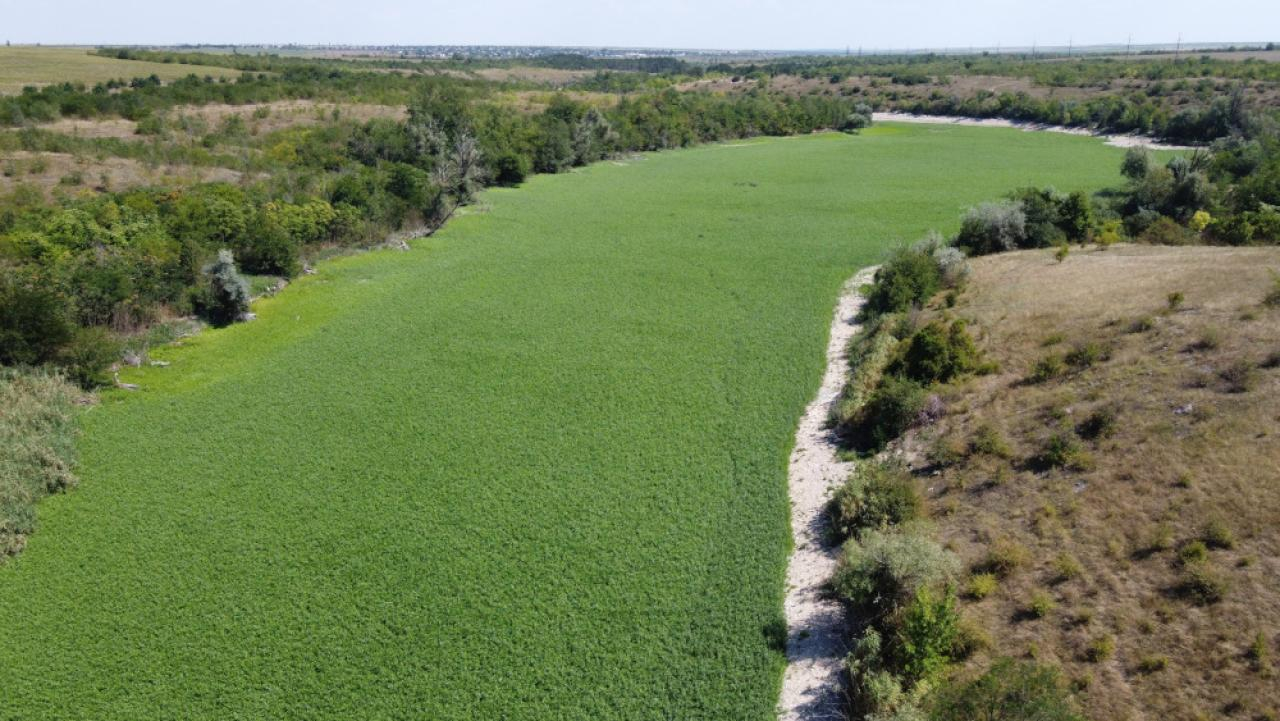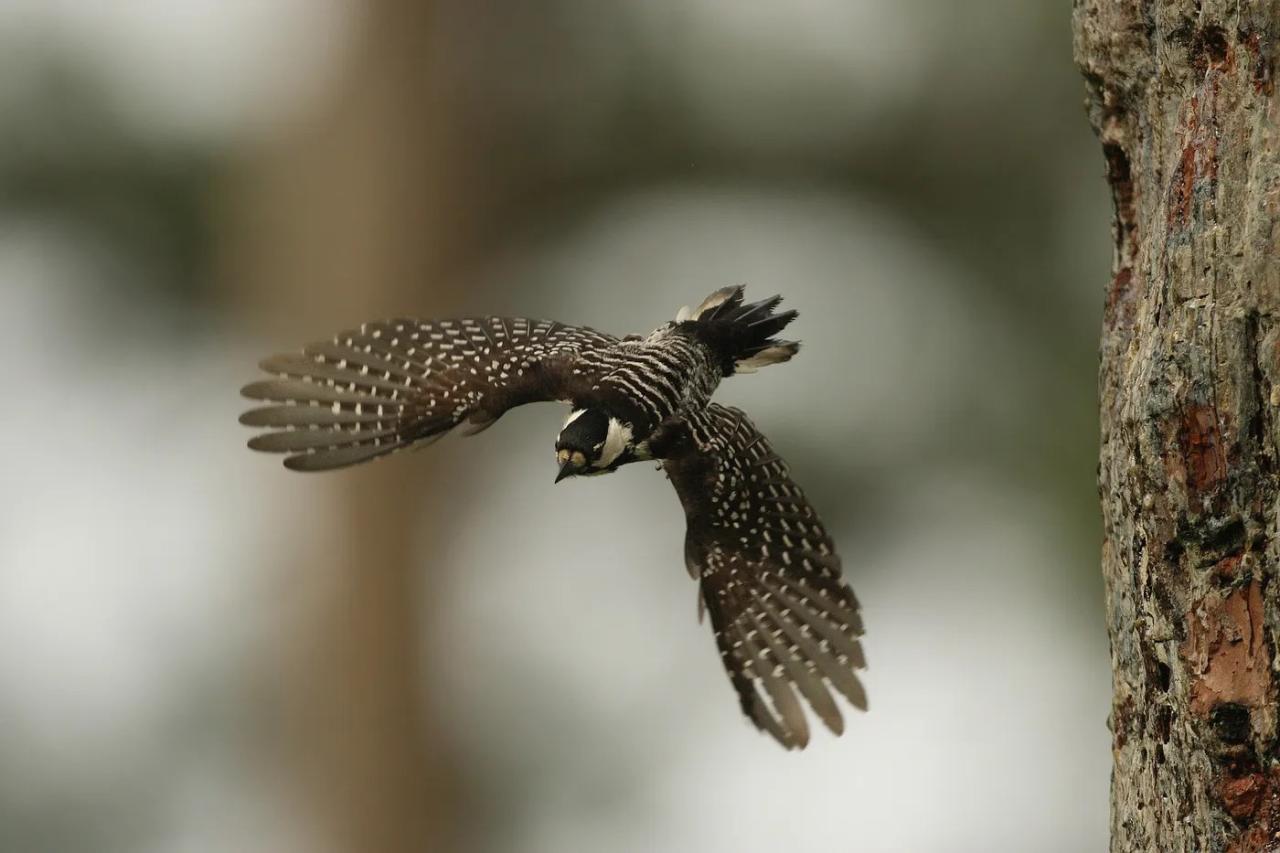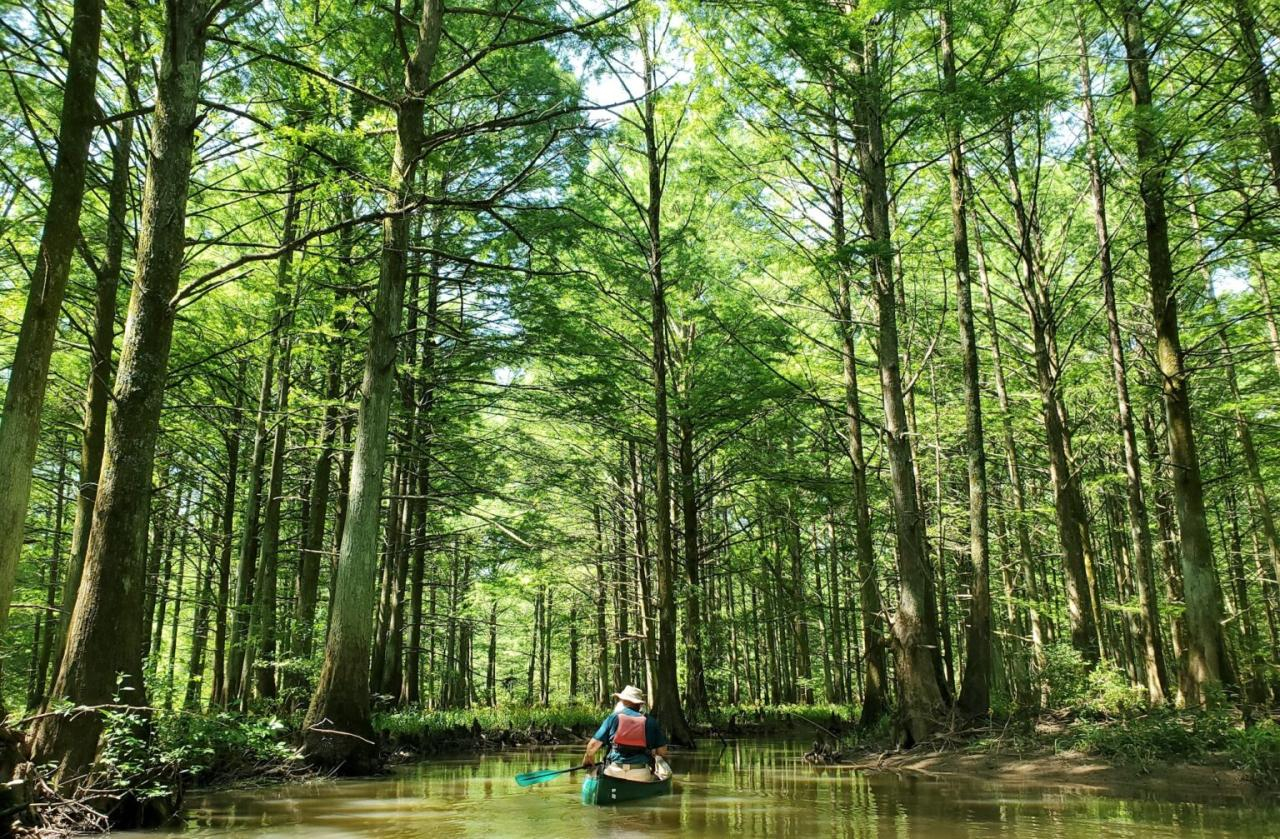
15 Life on Land (152)
Protect, restore and promote sustainable use of terrestrial ecosystems, sustainably manage forests, combat desertification, and halt and reverse land degradation and halt biodiversity loss
In war-torn Ukraine, nature refills reservoir destroyed by Russia
Written by Ruchi Kumar A range of vegetation has moved into the former Kakhovka reservoir in Ukraine. Russian occupying forces destroyed the dam along the Dnieper River in June 2023. Photos by Serhiiy Skoryk
A range of vegetation has moved into the former Kakhovka reservoir in Ukraine. Russian occupying forces destroyed the dam along the Dnieper River in June 2023. Photos by Serhiiy Skoryk
Russia’s bombing of Kakhovka Dam in 2023 killed hundreds of people and tens of thousands of animals, but it also provided a potential ecological reset.
This story was originally published by The Revelator.
KYIV — In the early hours of June 6, 2023, two large explosions reverberated across cities and small towns located on the banks of the Dnieper River in southern Ukraine. The Russian military had reportedly set off multiple bombs, destroying the three-kilometer-long Kakhovka Dam and draining its massive reservoir into nearby settlements.
Water from the dam flooded the plains, killing hundreds of civilians and countless livestock, destroying farms, and displacing the residents of more than 37,000 homes.
The bombing made headlines around the world. It’s the long-term impact of the attack on the local biodiversity, however, that has scientists and experts concerned. In the weeks following the explosion, researchers from Ukrainian ministries and independent organizations carried out several assessments as best they could to the backdrop of the war.
They found that the attack had flooded about 60,000 hectares (230 square miles) of forest in at least four national parks, threatening an estimated population of 20,000 animals and 10,000 birds.
 Serhiiy Skoryk, a national park director, is seen with landmines that are typical of those that have literally flooded the conflict zone during the Russian occupation of parts of Ukraine. These mines and other hazards complicate efforts to gauge the impact of the Russian invasion on Ukraine’s unique natural environment.
Serhiiy Skoryk, a national park director, is seen with landmines that are typical of those that have literally flooded the conflict zone during the Russian occupation of parts of Ukraine. These mines and other hazards complicate efforts to gauge the impact of the Russian invasion on Ukraine’s unique natural environment.
- russian ukraine conflict
- russian ukraine war
- ukraine war
- ukraine reservoir
- war and nature
- war effects on environment
- war pollution ukraine
- war affects on environment
- the revelator
- kakhovka dam
- dnieper river
- rewilding
- nature reclaiming reservoirs
- examples of nature reclaiming reservoirs
- legacy landmines
- landmine dangers
Red-cockaded woodpecker gets new lease on wild life
Written by Georgia Department of Natural Resources A red-cockaded woodpecker in flight. The U.S. Fish and Wildlife Service announced last month the bird had been removed from the Endangered Species List. Martjan Lammertink/USFS
A red-cockaded woodpecker in flight. The U.S. Fish and Wildlife Service announced last month the bird had been removed from the Endangered Species List. Martjan Lammertink/USFS
Staccato voice of Southern woodlands removed from Endangered Species List
ATLANTA — Life is looking up for red-cockaded woodpeckers.
These perky, family-focused woodpeckers of mature Southeastern pinelands — they’re the nation’s only woodpecker that excavates cavities in living pines — had been federally listed as endangered for 50 years. Yet late last month, the U.S. Fish and Wildlife Service downlisted them to threatened.
Their recovery from an estimated 1,470 family groups in the 1970s to about 7,800 groups today from Virginia to Texas reflects decades of work by government agencies, nonprofits and private landowners.
Georgia mirrors that outlook and effort. The number of red-cockaded woodpecker family groups here “is now well north of 1,500,” said Joe Burnam, lead Department of Natural Resources biologist for the species.
The success story ranges from military lands like Fort Stewart, where controlled burns and “recruitment” clusters of artificial nest cavities inserted in trees are helping the population grow, to southwest Georgia quail properties enrolled in Safe Harbor, part of a U.S.-first habitat conservation plan that DNR developed in 1999 for the woodpeckers and private landowners.
Burnam said the downlisting keeps federal protections in place and will not affect DNR conservation practices in the state. “We’ll continue to do what we’ve been doing … managing for the birds (and) their habitat.”
Habitat loss and degradation, a combo that landed the woodpeckers on the Endangered Species Act list, remain the leading threats. For example, Hurricane Helene wiped out over 40 percent of the nest cavity trees at Moody Forest Wildlife Management Area and Natural Area near Baxley.
But new cavity inserts have already been chainsawed into pines, and others will be added, Burnam said.
TennGreen protects unique stream habitat amid population boom
Written by TennGreen Land Conservancy![springcreek]() Preservation of the Spring Creek watershed near Cedars of Lebanon State Park will protect water resources in a rapidly growing part of the Southeast. TennGreen Land ConservancyTennessee cave salamanders, other wildlife will benefit from creation of unique preserve
Preservation of the Spring Creek watershed near Cedars of Lebanon State Park will protect water resources in a rapidly growing part of the Southeast. TennGreen Land ConservancyTennessee cave salamanders, other wildlife will benefit from creation of unique preserve
LEBANON — TennGreen Land Conservancy joined with Headwaters Reserve LLC to protect and restore a high-risk stream habitat adjacent to Cedars of Lebanon State Park. Located on approximately 47 acres, the property’s streams and wetlands are protected by a conservation easement held by TennGreen in perpetuity.
The waters of this property, called Cedar Forest, are within the Spring Creek watershed, which has been noted to contain more than 28 rare species, including the Tennessee cave salamander (Gyrinophilus palleucus).
Stream restoration, a vital process that breathes new life into natural aquatic environments, is a key objective of this conservation easement, offering numerous benefits to both wildlife and the community.
This permanent protection and intentional restoration will help to remove pollutants from waters in one of the nation’s fastest-growing counties while protecting the resource for generations to come.
TennGreen has previously conserved land in the area to expand Cedars of Lebanon State Park and Natural Area and Cedars of Lebanon State Forest.
Editorial: Fight legislation that rolls back environmental protections
Written by Dan Ritzman “Freedom of Speech.” Norman Rockwell/Library of Congress
“Freedom of Speech.” Norman Rockwell/Library of Congress
Stand up for wildlands, wildlife and water — all threatened by proposed Congressional bills
Dan Ritzman is director of the Sierra Club Conservation Campaign.
WASHINGTON, D.C. — Our public lands are facing unprecedented threats, and time is running out to protect them. Scientists tell us we need to double the amount of protected lands and waters in America by 2030 to fight the climate and extinction crisis. Congress is pushing through several dangerous bills that could dismantle essential safeguards and open up our natural treasures to devastating exploitation.
Here’s the urgent situation and what we’re fighting against:
- Fix Our Forests Act (HR 8790): This bill could weaken environmental protections, promote excessive logging and bypass crucial reviews, risking the health of our forests and worsening climate change.
- Save Our Sequoias Act (HR 2989): While claiming to protect Giant Sequoias, this legislation could actually harm these iconic trees by speeding up logging projects and removing key environmental protections.
- Forest Information Reform Act (FIR Act) (HR 200) & Senate Bill S 1540: These bills would exempt the Forest Service and Bureau of Land Management from critical environmental consultations and reviews, ignoring new information and putting endangered species at risk.
- Cottonwood S1540: This bill aims to undermine important environmental checks established by previous court decisions, threatening sensitive habitats and wildlife.
- Wyoming Public Lands Initiative (S1348): This proposal could compromise protections for Wyoming’s public lands, increasing resource extraction and reducing conservation efforts.
Protecting wild places will keep drilling and logging from dumping pollution into the air, sequester emissions, provide protection from extreme weather, homes for wildlife and opportunities for people to enjoy the outdoors together.
Your support today will help ensure that our public lands remain protected for future generations.
Save our salamanders: Shoot wild swine in Big South Fork for $5
Written by Daniel Banks Wild hogs root in a sensitive area in Big South Fork National River and Recreation Area. National Park Service
Wild hogs root in a sensitive area in Big South Fork National River and Recreation Area. National Park Service
Tennessee side of Big South Fork best for hunting invasive hogs
Daniel Banks is a public information officer at Big South Fork National River and Recreation Area.
ONEIDA — Deer hunting season opened in Kentucky on Sept. 7 and opens in Tennessee on Sept. 28. During these big game seasons, wild hogs may be harvested by licensed hunters with the appropriate weapon that is legal for that specific season.
There is also an extended hog hunting season that lasts from the end of the deer season until the end of February with a weapon that is approved by that state for harvesting big game.
The wild hog is an invasive exotic species that has a significant negative impact on native species and do a great deal of damage to farmlands and residential areas. The damage they cause threatens park resources, including federally listed plants. (Their rooting also damages salamander and other amphibian habitat).
(Check out this video of natural pest control: A bear eating a hog in Great Smoky Mountains National Park).
Tennessee Fish and Wildlife commission returns to Paris Landing
 Tennessee State Parks
Tennessee State Parks
BUCHANAN — The Tennessee Fish and Wildlife Commission will return to Paris Landing State Park for the first time in 15 years for a one-day meeting on Friday, Sept. 20. The meeting will start at 9 a.m.
A new video titled “Safe Boating Near Locks and Dams” will be presented. The video was produced by the Tennessee Wildlife Resources Agency in partnership with, Tennessee Valley Authority, U.S. Army Corps of Engineers, U.S. Coast Guard and Hardin County Emergency Management Agency.
Retired TWRA Wildlife and Forestry employee Mark Gudlin will be recognized for his induction into the National Bobwhite and Grasslands Initiative Hall of Fame. He served in a variety of roles during a 38-year TWRA career and was serving as Habitat Program Manager upon his retirement in 2021.
Will Bowling from the Rocky Mountain Elk Foundation will be recognized for a donation from the Foundation and the Mildred T. Edwards Trust. The gift will go toward purchasing a 1,322-acre tract at North Cumberland Wildlife Management Area.
There will also be a preview for rules and regulations governing licenses, permit fees and boating certificates.
Don’t hate the diggers. Hate the ginseng game.
Written by Justin Law A ginseng digger works a hollow somewhere in the Appalachians. Traditional ‘sangers’ generally follow centuries-old protocols for sustainable harvest of the plant and pose much less of a threat to ginseng than habitat destruction and extractive industry. Photos from American Folklife Collection/Library of Congress
A ginseng digger works a hollow somewhere in the Appalachians. Traditional ‘sangers’ generally follow centuries-old protocols for sustainable harvest of the plant and pose much less of a threat to ginseng than habitat destruction and extractive industry. Photos from American Folklife Collection/Library of Congress
Wild ginseng is declining, but small-scale ‘diggers’ aren’t the main threat to this native plant — and they can help save it
This article was originally published by The Conversation. Justine Law is an associate professor of Ecology and Environmental Studies at Sonoma State University.
KNOXVILLE — Across Appalachia, September marks the start of ginseng season, when thousands of people roam the hills searching for hard-to-reach patches of this highly prized plant.
Many people know ginseng as an ingredient in vitamin supplements or herbal tea. That ginseng is grown commercially on farms in Wisconsin and Ontario, Canada. In contrast, wild American ginseng is an understory plant that can live for decades in the forests of the Appalachians. The plant’s taproot grows throughout its life and sells for hundreds of dollars per pound, primarily to East Asian customers who consume it for health reasons.
Because it’s such a valuable medicinal plant, harvesting ginseng has helped families in mountainous regions of states such as Kentucky, West Virginia, Tennessee, North Carolina and Ohio weather economic ups and downs since the late 1700s.
Growing a Food Forest
Tuesday, Sept. 10, 2024, 5:30 p.m. at Barrelhouse by Gypsy Circus (621 Lamar Street). RSVP on Facebook
Green Drinks Knoxville will host an in-depth discussion with Dave Maasberg on how he maintains his food forest including some rare heirloom apple varieties, figs, pears, blackberries and more. He will bring samples to try and fruits for purchase to savor at home.

Raised around agriculture and the vanishing small-scale, midwestern family farm, Dave has always held a special place for fruit trees and perennial plants. After a Foraging and Wild Edible Plants class at Indiana University, his desire to create a food forest and sustainable homestead quickly turned into a reality. After over 20 years of planting and maintaining various fruiting plants on a reclaimed hillside, he is excited to share his journey with us. He currently helps others with plantings, from small scale to larger projects.
Green Drinks Knoxville is a social and professional organization that convenes open-minded folks to encourage education and conversation about the environment, green technologies, sustainable lifestyles and more.
Our events are free and open to the public. We welcome all and support racial diversity, gender equality, and LGBTQ inclusivity.
Pending state conservation deal would protect forest and water resources
Written by Cassandra Stephenson A man paddles down the main stem of the Wolf River in West Tennessee. The state is working to purchase 5,477 acres of forest land near Grand Junction from the Hobart Ames Foundation. The land is part of the Wolf River watershed. Wolf River Conservancy
A man paddles down the main stem of the Wolf River in West Tennessee. The state is working to purchase 5,477 acres of forest land near Grand Junction from the Hobart Ames Foundation. The land is part of the Wolf River watershed. Wolf River Conservancy
The roughly 5,500-acre property features wetland forest used for research by the University of Tennessee
This article was originally published by Tennessee Lookout.
GRAND JUNCTION — About 60 miles east of Memphis near the Mississippi line, verdant hardwood trees and ecologically exceptional streams weave through thousands of acres of rolling hills.
The land is home to a diverse array of aquatic and terrestrial life, decades-old archaeological sites and a watershed that feeds into the aquifer where hundreds of thousands of Memphians source their drinking water.
If all goes to plan, 5,477 acres of this land will soon become Tennessee’s newest state forest, securing its preservation for posterity.
The land is a portion of the 18,400-acre historic Ames Plantation, a privately owned tract in Fayette and Hardeman Counties amassed by Massachusetts industrialist Hobart Ames in the early 1900s.
- memphis aquifer
- memphis drinking water
- land conservation
- west tennessee land preservation
- drinking water protections
- cassandra stephenson
- tennessee lookout
- conservation fund
- ames plantation
- wolf river
- wolf river conservancy
- ut ag research
- hobart ames foundation
- tennessee state forests
- state forests in tn
- grand junction, tennessee
- ford blue oval
- heritage conservation trust
- forest service legacy program
Ginseng collection banned in Pisgah, Nantahala national forests
Written by Adam Rondeau The long maturation time of American ginseng makes it susceptible to overharvesting. A ban on collecting the plant in Nantahala and Pisgah national forests remains in place. Illstration: Ohio State Extension Service
The long maturation time of American ginseng makes it susceptible to overharvesting. A ban on collecting the plant in Nantahala and Pisgah national forests remains in place. Illstration: Ohio State Extension Service
Wild populations of the plant remain too low to sustainably harvest
Adam Rondeau is a public affairs specialist with the U.S. Forest Service.
ASHEVILLE — The Forest Service pause on issuing permits to harvest American ginseng in the Nantahala and Pisgah national forests will remain in place for the 2024 season.
Efforts to restore ginseng populations on both national forests continue. However, wild populations of the plant currently remain too low to sustainably harvest for the foreseeable future. The plant is known as both a folk and medical remedy and preventative for myriad ailments.
“We stopped issuing permits for ginseng harvesting in 2021, when the data began to show a trend toward lower and lower populations each year,” said Gary Kauffman, botanist for the National Forests in North Carolina. “We’re seeing that trend reversing slightly, but ginseng plants take a long time to mature before they reach the peak age to start bearing seeds.”
Native to Western North Carolina forests, wild ginseng is a perennial plant that can live for 60-80 years. It can take up to 10 years before a ginseng plant will start producing the most seeds; however, overharvesting in the past has made older plants increasing rare.
More...
Flutter over for educational fun at the annual UT Arboretum Butterfly Festival

OAK RIDGE — More than 2,500 people are expected to attend the ninth annual Butterfly Festival hosted by the University of Tennessee Arboretum Society and the UT Forest Resources AgResearch and Education Center. Gates will open at 9:30 a.m. Saturday, Sept. 28, at the UT Arboretum,
The festivities will take place from 10 a.m. to 1 p.m. EDT. Plenty of activities will provide educational opportunities for the public to learn how we can all protect butterflies and other pollinators.
Kevin Hoyt, director of the UT Forest Resources Center and Arboretum, invites everyone to come for a fun day of educational activities. “This family-oriented event will feature butterfly tents and the UT Insect Zoo as well as children’s crafts, artisans and other vendors and food trucks.” Hoyt said butterfly releases are no longer part of the event and that guests are asked to leave pets and butterfly nets at home.
Mountain monarchs inspired Wanda DeWaard’s legacy of citizen science
Written by Élan Young Wanda DeWaard has spent 30 years studying and tagging monarch butterflies. Here she leads a volunteer group of citizen scientists tagging monarchs in Cades Cove. Photos courtesy of Wanda DeWaard
Wanda DeWaard has spent 30 years studying and tagging monarch butterflies. Here she leads a volunteer group of citizen scientists tagging monarchs in Cades Cove. Photos courtesy of Wanda DeWaard
Successful Smokies monarch tagging project is a product of the people
Every winter, way up in the oyumel firs in Mexico’s high elevation forests, millions of North American monarch butterflies that have traveled from as far north as Canada cluster in colonies to overwinter before flying north again to lay eggs in spring. Tens of thousands of monarchs might adorn a single tree like a papery gown, sometimes weighing it down enough to break off branches.
To get to the oyumel forests several miles above sea level, which provide a perfect microclimate for the weary travelers, they migrate south using different aerial paths, or flyways, that merge together over Central Texas. This migrating generation can live up to nine months and might travel anywhere from 1,000-3,000 miles to the forests they seek, yet have never been to. Mysteriously, they find their way and sometimes even make it to the exact tree where their ancestors four or five generations back once clustered.
Monarchs are the only butterfly that makes a long two-way migration. Despite much research on the species, science still hasn’t fully unraveled the secrets of their incredibly accurate homing system. This makes them one of the true marvels of the natural world.
 A tagged monarch feeds on nectar in the Great Smokies before joining the migration to Mexico for the winter.
A tagged monarch feeds on nectar in the Great Smokies before joining the migration to Mexico for the winter.
- monarch butterflies
- smokies monarchs
- wanda dewaard
- monarch tagging program
- eastern north american monarch butterflies
- monarchs in mexico
- oyumel firs
- great smoky mountains institute at tremont
- tremont butterflies
- tremont tagging
- tremont butterfly tagging
- elan young journalist
- register for monarch tagging
- citizen science
- monarch watch
- milkweed
- milkweed toxic to birds
- monarch conservation
Ijams pays homage to our flying friends at science soiree
Written by Thomas Fraser The live animal shows and educational lectures were a big draw during the annual Ijams Nature Center Hummingbird Festival held Aug. 17 at the center in Knoxville. Photos by John White/phocasso for Hellbender Press
The live animal shows and educational lectures were a big draw during the annual Ijams Nature Center Hummingbird Festival held Aug. 17 at the center in Knoxville. Photos by John White/phocasso for Hellbender Press Annual Hummingbird Festival showcases Appalachia’s airborne denizens
 Children learn about the four seasons during one of many immersive educational activities available during the Aug. 17 Hummingbird Festival at Ijams Nature Center.
Children learn about the four seasons during one of many immersive educational activities available during the Aug. 17 Hummingbird Festival at Ijams Nature Center. Hunt mushrooms in the Smokies for the 2024 Continental Mycoblitz

This event was postponed on a previous date.
GATLINBURG — Partner with Discover Life in America to find and collect mushrooms and fungi specimens for identification and DNA sequencing and learn more about the diversity of Great Smoky Mountains National Park.
Register here for the event, set for 10 a.m. to 3 p.m. Oct. 16 at Twin Creeks, 1316 Cherokee Orchard Road in Gatlinburg.
The fungi roundup is in conjunction with the Summer 2024 Continental Mycoblitz, a continentwide fungi data-collection project.
Expect a 1-2 mile easy to moderate hike. Email Jaimie Matzko, This email address is being protected from spambots. You need JavaScript enabled to view it., for more information.
